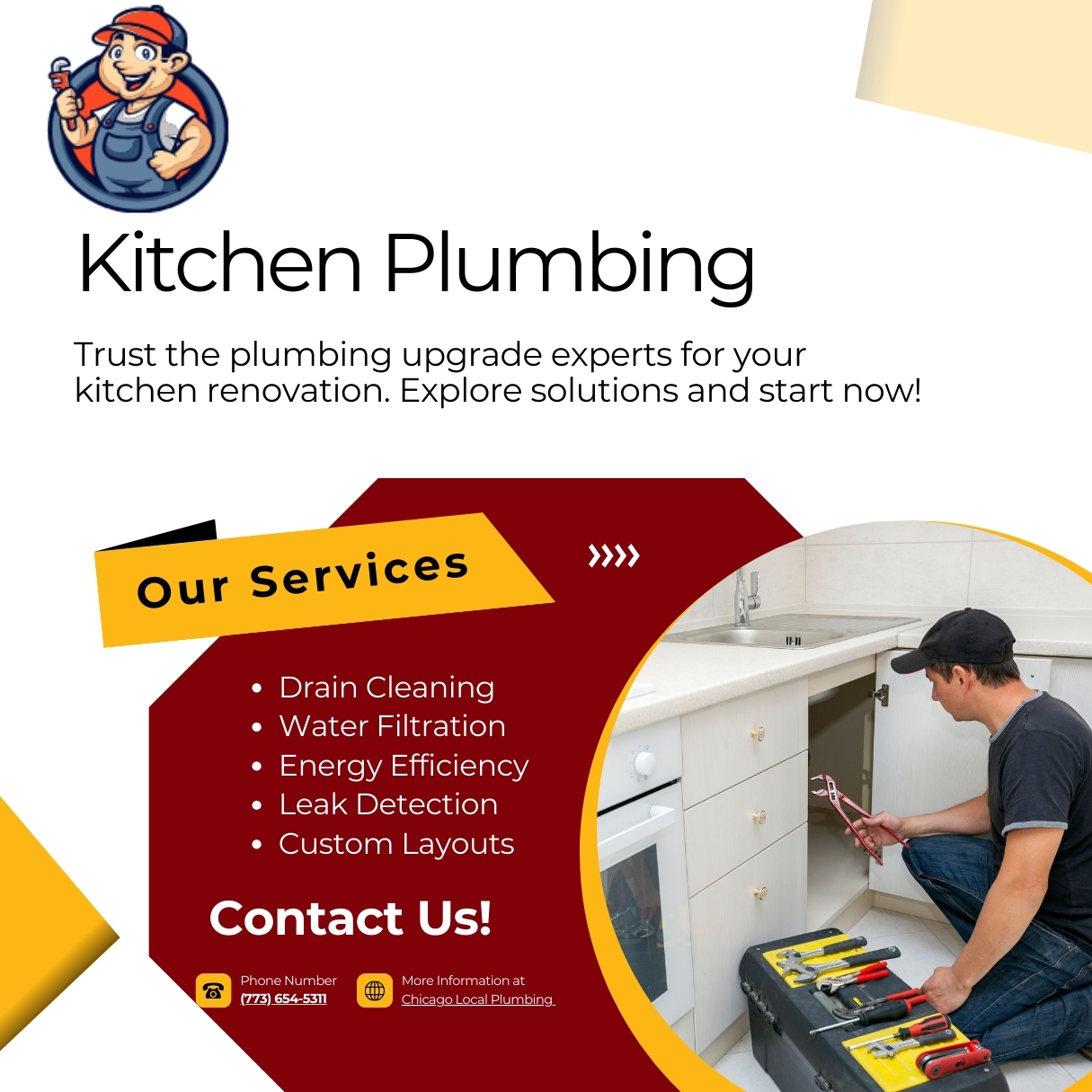Comprehensive kitchen plumbing services, including installation, repair, and maintenance for sinks, faucets, and pipes

Call Us Today To Get Services (773) 654-5311
Kitchen plumbing involves several critical systems and components that need to work seamlessly for efficient daily use. Here’s a comprehensive guide to understanding and managing kitchen plumbing:
1. Key Components of Kitchen Plumbing
A. Sink
- Faucet: Provides water for various kitchen tasks. Can include features like pull-out sprayers, touchless operation, and multi-function settings.
- Sink Basin: The main receptacle where dishes and food are washed.
- Drain Assembly: Includes the strainer, stopper, and trap. Directs wastewater away from the sink.
B. Garbage Disposal
- Function: Shreds food waste into small pieces to be washed away through the plumbing system.
- Components: Includes a motor, grinding chamber, and flywheel.
C. Dishwasher
- Connection: Connects to the sink’s drain and water supply.
- Drain Line: Discharges wastewater into the kitchen sink or a dedicated drain.
D. Water Supply Lines
- Hot and Cold Lines: Supply water to the sink, dishwasher, and any additional appliances.
2. Common Kitchen Plumbing Issues
A. Clogged Sink
- Causes: Food scraps, grease, or foreign objects blocking the drain.
- Solutions: Use a plunger, drain snake, or a chemical cleaner. For persistent clogs, a plumber may need to inspect deeper issues.
B. Leaky Faucet
- Causes: Worn-out washers, cartridges, or O-rings.
- Solutions: Replace the faulty parts or the entire faucet if necessary.
C. Garbage Disposal Problems
- Causes: Jams from non-food items, overloading, or mechanical issues.
- Solutions: Use the reset button, manually turn the flywheel, or clear the jam. If the unit is faulty, replacement might be needed.
D. Dishwasher Drainage Issues
- Causes: Clogged drain lines, a blocked air gap, or problems with the dishwasher pump.
- Solutions: Check and clean the air gap, inspect the drain line for clogs, or address issues with the pump.
E. Low Water Pressure
- Causes: Clogged aerators, partially closed valves, or pipe issues.
- Solutions: Clean or replace the aerator, ensure valves are fully open, or check for blockages in pipes.
3. Installation Tips
A. Sink Installation
- Placement: Ensure the sink is positioned correctly for plumbing connections.
- Mounting: Secure the sink to the countertop or base cabinet.
- Connecting: Attach the faucet, drain assembly, and supply lines. Check for leaks.
B. Garbage Disposal Installation
- Mounting: Secure the disposal unit to the sink flange.
- Wiring: Connect the electrical wiring according to the manufacturer’s instructions.
- Plumbing Connections: Attach the drain line and ensure all connections are secure.
C. Dishwasher Installation
- Positioning: Place the dishwasher close to the sink for easy connections.
- Water Supply: Connect the supply line to the hot water line under the sink.
- Drain Line: Attach the drain line to the sink drain or a dedicated drain.
4. Maintenance and Care
A. Regular Cleaning
- Faucet Aerators: Clean to prevent mineral buildup that can affect water flow.
- Sink Drains: Use a mixture of baking soda and vinegar to keep drains clear.
B. Preventive Measures
- Avoid Grease: Do not pour grease down the sink as it can cause clogs.
- Use Drain Screens: To catch food scraps and prevent clogs.
C. Seasonal Care
- Inspect for Leaks: Regularly check under the sink and around the garbage disposal.
- Check for Freezing Pipes: In colder climates, insulate pipes to prevent freezing.
5. When to Call a Professional
- Major Repairs: For significant leaks, pipe replacements, or complex issues, a professional plumber is needed.
- New Installations: Professional installation ensures that everything meets local codes and functions correctly.
6. Troubleshooting Tips
- No Water Flow: Check if the shut-off valves are open and if there’s an issue with the water supply.
- Strange Noises: If the garbage disposal is making unusual noises, it might be jammed or malfunctioning.
- Water Quality: If the water quality is poor, consider checking for issues with the plumbing system or installing a water filter.
By understanding these aspects of kitchen plumbing, you can manage common issues, perform basic maintenance, and know when to seek professional help. If you have any specific questions or need more details on a particular problem, feel free to ask!




